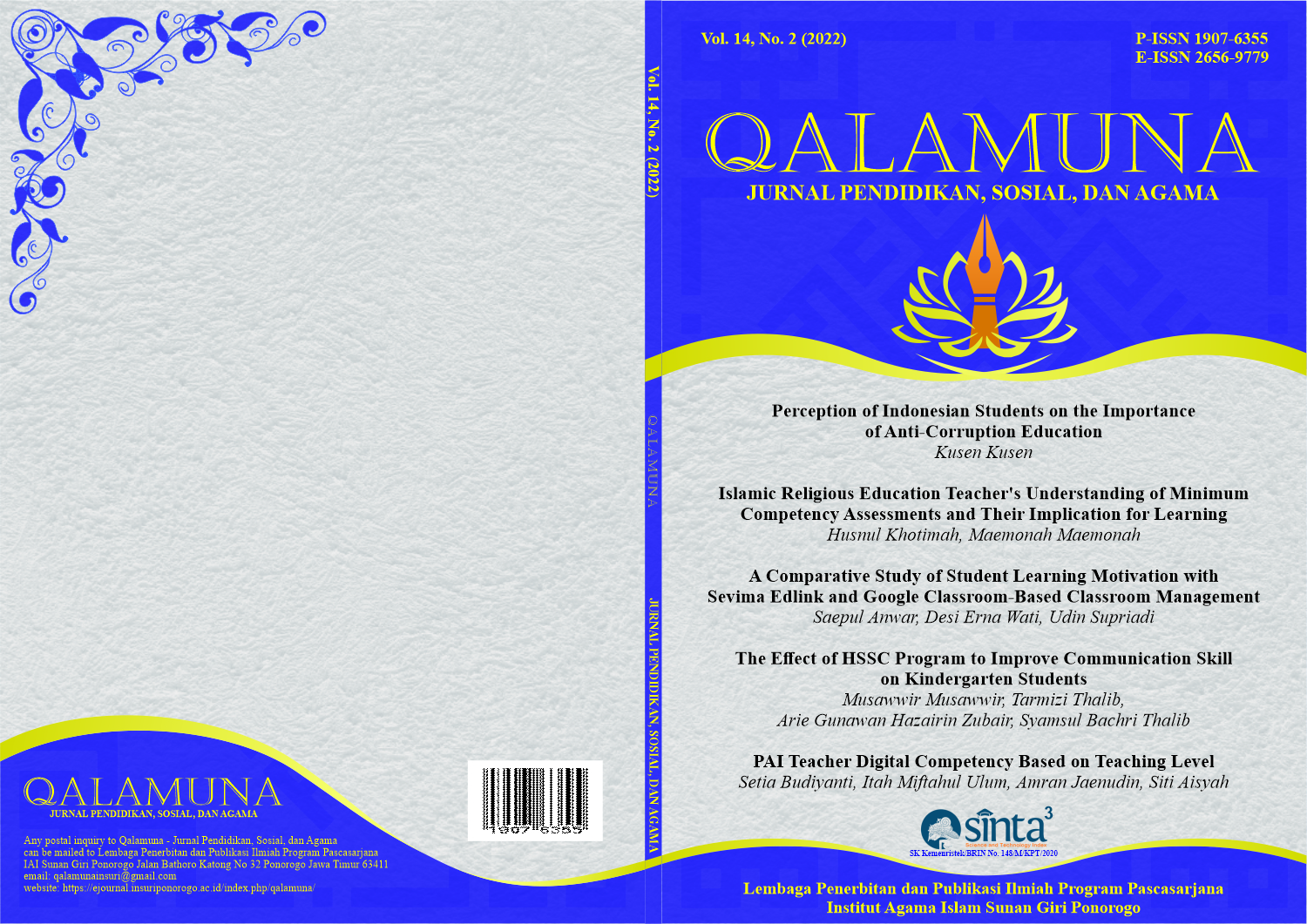The Prospective Elementary School Teacher Students' Opinion in Online Learning Using Virtual Learning Environments
DOI:
https://doi.org/10.37680/qalamuna.v14i2.3736Keywords:
online learning; virtual learning environments (VLE); Learning technologiesAbstract
Digital-based education, including virtual learning environments, has gained traction within the community. However, it is essential to acknowledge that not all online learning experiences are without drawbacks; they come with advantages and disadvantages. Therefore, the primary objective of this study is to investigate the perspectives of student candidates aspiring to become elementary school teachers regarding their experiences with online learning via virtual environments. The research methodology employed here is descriptive and qualitative. The study encompasses a participant pool of 60 students in their fifth semester. The findings of this research reveal that, on the whole, students exhibit satisfaction and comfort in using virtual learning environments. The incorporation of virtual learning environments contributes to a resource-efficient learning approach. Additionally, implementing these virtual environments nurtures self-confidence and independence among learners. Notably, the most significant advantage of online learning via virtual platforms from home is the ability to store learning materials, enabling students to revisit them as needed. This condition is made feasible by downloading online learning materials, allowing children to save and access them conveniently. However, challenges persist, including weak internet signals, limitations in delivering all materials online, and the students' demand for practical material examples.
References
Aluja-Banet, T., Sancho, M. R., & Vukic, I. (2019). Measuring motivation from the virtual learning environment in secondary education. Journal of Computational Science, 36, 100629.
Araka, E., Maina, E., Gitonga, R., & Oboko, R. (2020). Research trends in measurement and intervention tools for self-regulated learning for e-learning environments—systematic review (2008–2018). Research and Practice in Technology Enhanced Learning, 15, 1-21.
Auer, P. (2017). Online Learning. In C. Sammut & G. I. Webb (Eds.), Encyclopedia of Machine Learning and Data Mining (pp. 929–937). Springer US. https://doi.org/10.1007/978-1-4899-7687-1_618
Belawati, T. (2019). Pembelajaran Online. Universitas Terbuka, Indonesia.
Carter Jr., R. A., Rice, M., Yang, S., & Jackson, H. A. (2020). Self-regulated learning in online learning environments: strategies for remote learning. Information and Learning Sciences, 121(5/6), 321-329.
Egsaugm, (2020). Pembelajaran Daring, Efektif Gak Sih Buat Mahasiswa? accessed https://egsa.geo.ugm.ac.id/2020/10/14/pembelajaran-daring-efektif-gak-sih-buat-mahasiswa/.
Francis, M. K., Wormington, S. V., & Hulleman, C. (2019). The costs of online learning: Examining differences in motivation and academic outcomes in online and face-to-face community college developmental mathematics courses. Frontiers in Psychology, 10, 2054.
Gallagher, S., & LaBrie, J. (2012). Online learning 2.0: Strategies for a mature market. Continuing Higher Education Review, 76.
Gallego, G., & Topaloglu, H. (2019). Online Learning. In G. Gallego & H. Topaloglu (Eds.), Revenue Management and Pricing Analytics (pp. 275–289). Springer, New York. https://doi.org/10.1007/978-1-4939-9606-3_10
Hazan, E., & Megiddo, N. (2007). Online Learning with Prior Knowledge. In N. H. Bshouty & C. Gentile (Eds.), Learning Theory (pp. 499–513). Springer Berlin Heidelberg.
Hamilton, D., McKechnie, J., Edgerton, E., & Wilson, C. (2021). Immersive virtual reality as a pedagogical tool in education: a systematic literature review of quantitative learning outcomes and experimental design. Journal of Computers in Education, 8(1), 1-32.
Hsu, H. C. K., Wang, C. V., & Levesque-Bristol, C. (2019). I am reexamining the impact of self-determination theory on learning outcomes in the online learning environment. Education and information technologies, 24, 2159-2174.
Huang, Y. C., Backman, S. J., Backman, K. F., McGuire, F. A., & Moore, D. (2019). An investigation of motivation and experience in virtual learning environments: a self-determination theory. Education and Information Technologies, 24, 591-611.
Jin, S.-H., Im, K., Yoo, M., Roll, I., & Seo, K. (2023). Supporting students' self-regulated learning in online learning using artificial intelligence applications. International Journal of Educational Technology in Higher Education, 20(1), 37. https://doi.org/10.1186/s41239-023-00406-5
Kassymova, G., Akhmetova, A., Baibekova, M., Kalniyazova, A., Mazhinov, B., & Mussina, S. (2020). E-Learning environments and problem-based learning. International Journal of Advanced Science and Technology, 29(7), 346-356.
Kurniawati, D. O., & Muhajjalin, A. G. (2020). Tinjauan E-Learning Untuk Teknologi Energi Baru Terbarukan Di Pendidikan Tinggi Indonesia. Jurnal JE-UNISLA: Electronic Control, Telecomunication, Computer Information and Power System, 5(2), 376-382.
Mu’awwanah, U., Marini, A., & Sumantri, M. S. (2021). Kebijakan pemerintah tentang belajar dari rumah pada masa pandemi di kota Serang. Jurnal Basicedu, 5(3), 1518-1524.
Mulders, M., Buchner, J., & Kerres, M. (2020). A framework for the use of immersive virtual reality in learning environments. International Journal of Emerging Technologies in Learning (iJET), 15(24), 208-224.
Nishida, N., Yamakawa, M., Shiina, T., & Kudo, M. (2019). Current status and perspectives for computer-aided ultrasonic diagnosis of liver lesions using deep learning technology. Hepatology International, 13, 416-421.
Nakayama, M., & Santiago, R. (2012). Learner Characteristics and Online Learning. In N. M. Seel (Ed.), Encyclopedia of the Sciences of Learning (pp. 1745–1747). Springer US. https://doi.org/10.1007/978-1-4419-1428-6_1858
Odrekhivskyy, M., Pasichnyk, V., Rzheuskyi, A., Andrunyk, V., Nazaruk, M., Kunanets, O., & Tabachyshyn, D. (2019). Problems of the Intelligent Virtual Learning Environment Development. MoMLeT, 2019, 359-369.
Rani Lidiawati, K. (2021). Online learning during COVID-19 pandemic: How self-regulated learning strategies impact student engagement? Jurnla Psibernetika, 14(1), 1–10. https://doi.org/10.30813/psibernetika.v14i1.2570
Rachmadtullah, R., Zulela, M. S., & Syarif Sumantri, M. (2019, March). Computer-based interactive multimedia: a study on the effectiveness of integrative thematic learning in elementary schools. In Journal of Physics: Conference Series (Vol. 1175, p. 012028). IOP Publishing.
Rodrigues, H., Almeida, F., Figueiredo, V., & Lopes, S. L. (2019). Tracking e-learning through published papers: A systematic review. Computers & Education, 136, 87-98.
Shamir-Inbal, T., & Blau, I. (2021). Facilitating emergency remote K-12 teaching in computing-enhanced virtual learning environments during the COVID-19 pandemic or curse? Journal of Educational Computing Research, 59(7), 1243-1271.
Singh, V., & Thurman, A. (2019). How many ways can we define online learning? A systematic literature review of definitions of online learning (1988-2018). American Journal of Distance Education, 33(4), 289-306.
Sonnenschein, S., Stites, M., & Ross, A. (2021). Home learning environments for young children in the US during COVID-19. Early Education and Development, 32(6), 794-811.
Sarnoto, A., Hidayat, R., Hakim, L., Sari, W., & Ika, I. (2023). Analisis Penerapan Teknologi dalam Pembelajaran dan Dampaknya terhadap Hasil Belajar. Journal on Education, 6, 82–92. https://doi.org/10.31004/joe.v6i1.2915
Sherry, L. (2019). Issues in distance learning. International Journal of Educational Telecommunications, 26(1), 1367–1385.
Shikhman, V., & Müller, D. (2021). Online Learning. In V. Shikhman & D. Müller (Eds.), Mathematical Foundations of Big Data Analytics (pp. 21–39). Springer Berlin Heidelberg. https://doi.org/10.1007/978-3-662-62521-7_2
Sims, L. (2021a). Emergence of Online Learning. In L. Sims (Ed.), Effective Digital Learning: Transforming Traditional Learning Models to a Virtual World (pp. 1–7). Apress. https://doi.org/10.1007/978-1-4842-6864-3_1
Sims, L. (2021b). Planning for Online Learning. In L. Sims (Ed.), Effective Digital Learning: Transforming Traditional Learning Models to a Virtual World (pp. 19–25). Apress. https://doi.org/10.1007/978-1-4842-6864-3_3
Sucipto, T. A. (2022). Efektivitas Penggunaan Teknologi Informasi untuk Pembelajaran Daring di Masa Pandemi. Jurnal Sains, Nalar, Dan Aplikasi Teknologi Informasi, 1(2). https://doi.org/10.20885/snati.v1i2.13
Sunal, C. S., & Wright, V. H. (2012). Online Learning. In N. M. Seel (Ed.), Encyclopedia of the Sciences of Learning (pp. 2499–2502). Springer US. https://doi.org/10.1007/978-1-4419-1428-6_388
Van Wart, M., Ni, A., Medina, P., Canelon, J., Kordrostami, M., Zhang, J., & Liu, Y. (2020). Integrating students' perspectives about online learning: a hierarchy of factors. International Journal of Educational Technology in Higher Education, 17(1), 53. https://doi.org/10.1186/s41239-020-00229-8
Wang, W., Guo, L., He, L., & Wu, Y. J. (2019). Effects of social-interactive engagement on the dropout ratio in online learning: insights from MOOC. Behavior & Information Technology, 38(6), 621-636.
Whalley, R., & Barbour, M. K. (2020). Collaboration and virtual learning in New Zealand rural primary schools: A literature review. Turkish Online Journal of Distance Education, 21(2), 102-125.
Yunusa, A. A., & Umar, I. N. (2021). A scoping review of critical predictive factors (CPFs) of satisfaction and perceived learning outcomes in E-learning environments. Education and Information Technologies, 26, 1223-1270.
Yusny, R., & Yasa, G. I. (2019). Mengembangkan (pembelajaran) blended learning dengan sistem lingkungan pembelajaran virtual (VLE) di PTKIN. Jurnal Ilmiah Islam Futura, 19(1), 103-127
Downloads
Published
How to Cite
Issue
Section
License
Authors who submit manuscript retain its copyright and grant publisher right of first publication licensed under a Creative Commons Attribution-ShareAlike 4.0 International License (CC BY-SA 4.0) that allows others to access (search, read, download, and cite), share (copy and redistribute the material in any medium or format) and adapt (remix, transform, and build upon any material) the work for any lawful purpose, even commercially with an acknowledgement of the work's authorship and initial publication in Qalamuna: Jurnal Pendidikan, Sosial, dan Agama.












